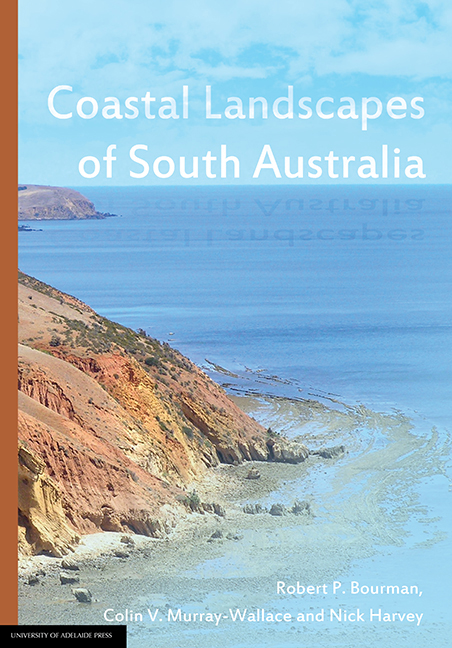Book contents
- Frontmatter
- Dedication
- Contents
- Preface
- Biographies
- Acknowledgements
- 1 Coastal landscapes of South Australia
- 2 The coast of metropolitan Adelaide
- 3 The Fleurieu Peninsula coast
- 4 The River Murray Estuary
- 5 The Coorong Coastal Plain and the Limestone Coast
- 6 The northern Gulf St Vincent tidal coastline (the Samphire Coast)
- 7 The Yorke Peninsula coastline
- 8 The northern Spencer Gulf coast
- 9 The Gulf Coast of Eyre Peninsula
- 10 The Bight Coast - West coast of Eyre Peninsula
- 11 Kangaroo Island
- 12 Explaining the coastal landscapes of South Australia - A synthesis
11 - Kangaroo Island
Published online by Cambridge University Press: 25 July 2017
- Frontmatter
- Dedication
- Contents
- Preface
- Biographies
- Acknowledgements
- 1 Coastal landscapes of South Australia
- 2 The coast of metropolitan Adelaide
- 3 The Fleurieu Peninsula coast
- 4 The River Murray Estuary
- 5 The Coorong Coastal Plain and the Limestone Coast
- 6 The northern Gulf St Vincent tidal coastline (the Samphire Coast)
- 7 The Yorke Peninsula coastline
- 8 The northern Spencer Gulf coast
- 9 The Gulf Coast of Eyre Peninsula
- 10 The Bight Coast - West coast of Eyre Peninsula
- 11 Kangaroo Island
- 12 Explaining the coastal landscapes of South Australia - A synthesis
Summary
Introduction
Kangaroo Island, Australia's third-largest island after Tasmania and Melville Island, is approximately 140 km long (east-west) and 55 km wide (north-south), with a coastline of some 458 km, and a land area of approximately 3890 km2. Coastal cliffs that developed on pre-Cenozoic bedrock, Paleogene-Neogene limestones and Pleistocene aeolianite (dune limestone) comprise approximately 66% of the island's coastline, while the remaining 34% of the coastline consists of sandy beaches. The island has 218 beaches, which average only 700 m in length. Kangaroo Island is separated from the mainland by Backstairs Passage, a stretch of water about 14 km wide between Dudley Peninsula, on the easternmost portion of the island, and Fleurieu Peninsula, on the mainland. In places, Backstairs Passage is an oversteepened bedrock depression formed by glacial erosion during the Early Permian (299 to 290 Ma). In the central portion of the passage, water depth exceeds 40 m; and closer to the island's coast, approximately 2 km to the east of Cape St Albans, it exceeds 80 m (Figure 11.1). In this region, an elongate bedrock depression trends in a northwesterly direction. The north coast of the island is separated from southernmost Yorke Peninsula by Investigator Strait, a stretch of water 50 km long and less than 55 m deep on the easternmost Lincoln Shelf.
With its long axis trending east-west, the island attenuates the impact of high-energy swell waves on Gulf St Vincent. The northwestern coastline of the island is bounded by the Lincoln Shelf, and its southern and eastern coastlines are bordered by the Lacepede Shelf (Figure 11.1). The edge of the continental shelf is approximately 60 km south of the island, where a spectacular series of submarine canyons (Murray Canyons Group) occurs. Some of these are among the largest in the world and remain active conduits for the transportation of continental shelf sediment to the deep sea. In contrast, the west-facing coastline between Cape Borda and Cape du Couedic is bounded by a narrow shelf, less than 10 km wide.
Regional geological setting
The regional landscape of Kangaroo Island comprises a weathered, partially dissected plateau surface mantled by deeply weathered regolith, including ferricrete developed on pre-Cenozoic bedrock. The plateau surface has been differentially uplifted and tilted with higher relief (250 m APSL) in the northwest of the island compared with the southeast, where the plateau surface is 50 m APSL.
- Type
- Chapter
- Information
- Coastal Landscapes of South Australia , pp. 355 - 386Publisher: The University of Adelaide PressPrint publication year: 2016



